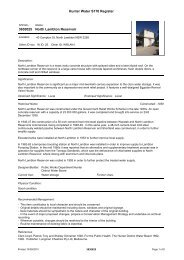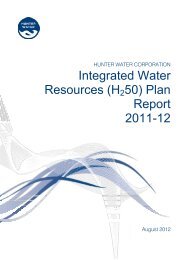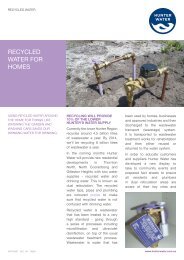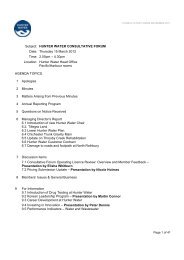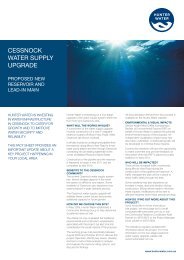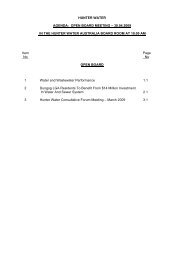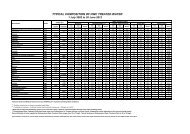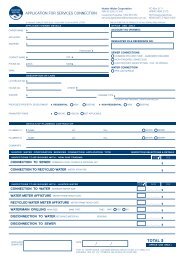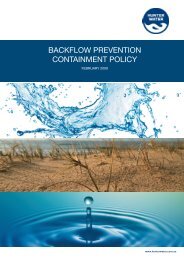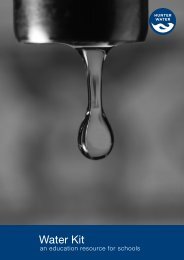Catchment Management Plan - Hunter Water
Catchment Management Plan - Hunter Water
Catchment Management Plan - Hunter Water
Create successful ePaper yourself
Turn your PDF publications into a flip-book with our unique Google optimized e-Paper software.
Using this model it is possible to beginanalysis of the areas that pose thegreatest risk to drinking water quality.For example, in Figures 18-20 the grazingareas that are the highest risk to waterquality from nitrogen, phosphorus andpathogens are shown in red. It can beseen that the south-east corner mightbe more effectively targeted for nutrientand pathogen reduction measuresfrom grazing above other parts of thecatchment.Ultimately, there will be another seven‘modules’ (such as Impact of roads andStormwater runoff) overlayed upon thecatchment maps. The final output will thenbe broken up into smaller drainage units thatcan be colour coded to represent risk andhelp prioritise catchment remediation works.3.1.5 <strong>Hunter</strong> <strong>Water</strong>’s vision toaddress catchment risksusing the SWISSThe top catchment priorities areranked using SWISS and fundingto address catchment prioritiesis requested in the next pricesubmission.Priority high risk areas are sequentiallyaddressed with on ground work, themodel is refined and rerun.The SWISS catchment model becomesan industry leading package and isintegrated into many land use changedecision making processes.HORIZON 1 HORIZON 2 HORIZON 3►This price path 2010 - 2013 Next price path 2013 - 2017 Our vision for the future 2017 - beyond►►Part 4: The action plan 2010-2013 explains in more detail how <strong>Hunter</strong> <strong>Water</strong> will move towards this vision.3.2 Element 2: Have effectivelegislationPurposeTo strengthen the legislationwithin the drinking watercatchment areas whereby new orproposed activities on land can bemanaged with a focus on water qualityprotection.PrécisA catchment’s water quality and landuse are inextricably linked. There aresome legislative controls which applyto catchments that require drinkingwater quality to be considered as aprimary concern. <strong>Hunter</strong> <strong>Water</strong> willstrengthen the legislation and ensurethat it is well integrated into local andregional planning instruments.3.2.1 Current status of landuse planning and developmentcontrol in catchmentsThe quality and quantity of source waterCATCHMENT MANAGEMENT PLAN . ssS . 001 . JUNE2010is largely dependent upon the activitiesthat occur in the catchment. Landuse planning legislation that ensuresdevelopments consider the quality andquantity of water are essential to maintainIncrease in the difficultyof maintaining effectivetreatmentIncrease in risk ofpollutants enteringtreatment systemIncrease in health riskto consumersFailure to implementappropriate planningcontrolsDecrease in the reliabilityof the water sourceor improve raw drinking water quality.Poor development choices in drinkingwater catchments can have the followingimpacts on drinking water quality 6 :6 Hurlimann, Ford (Feb 2010) Development control within catchments, <strong>Water</strong> magazine, AWAIncrease in costand complexity ofwater treatmentAbandonmentof catchments inextreme cases29




